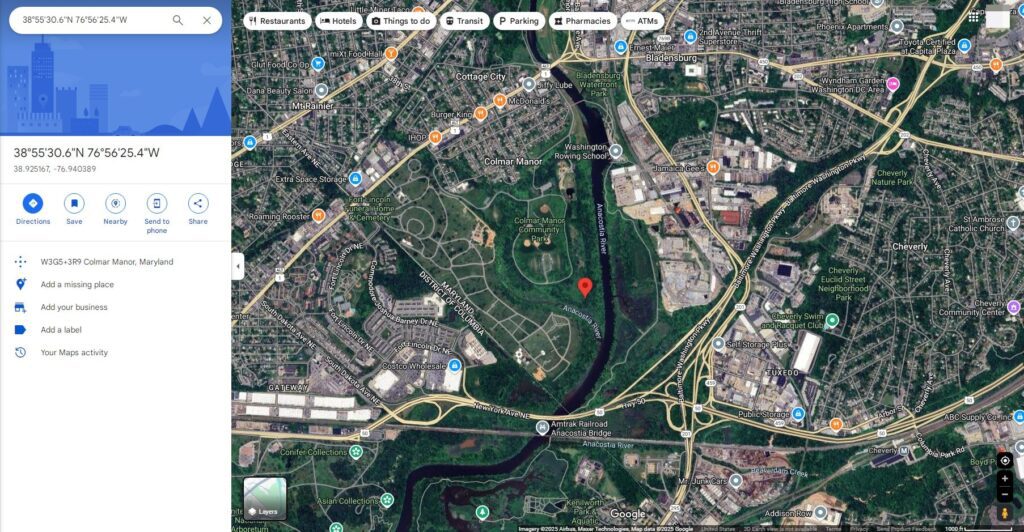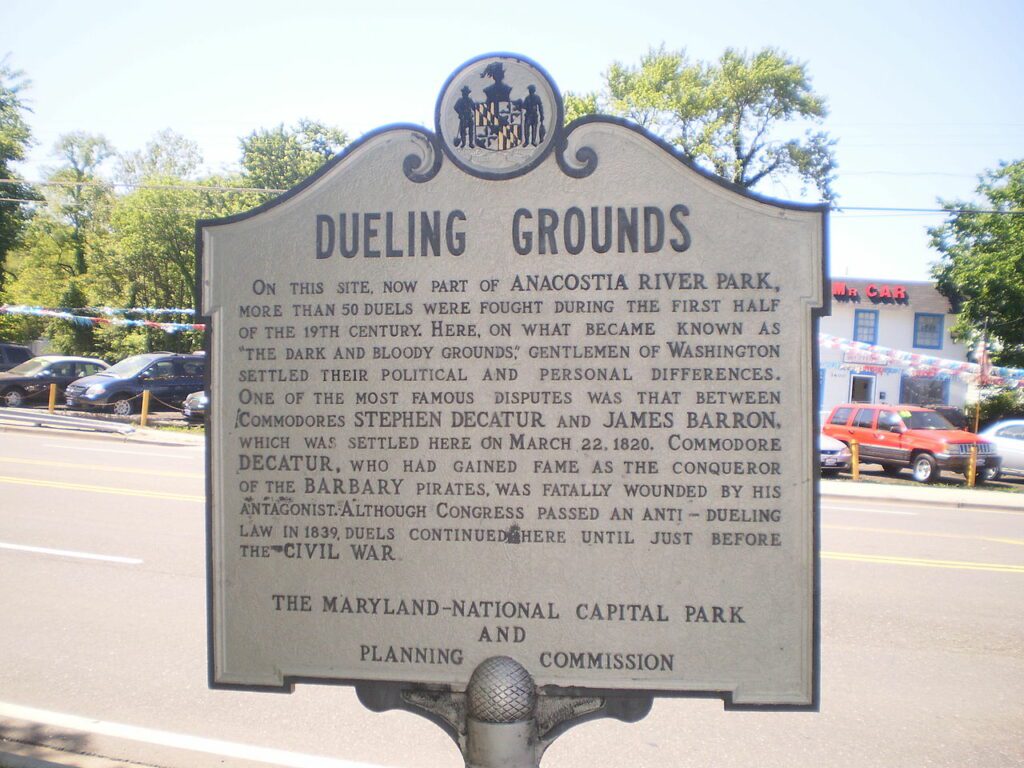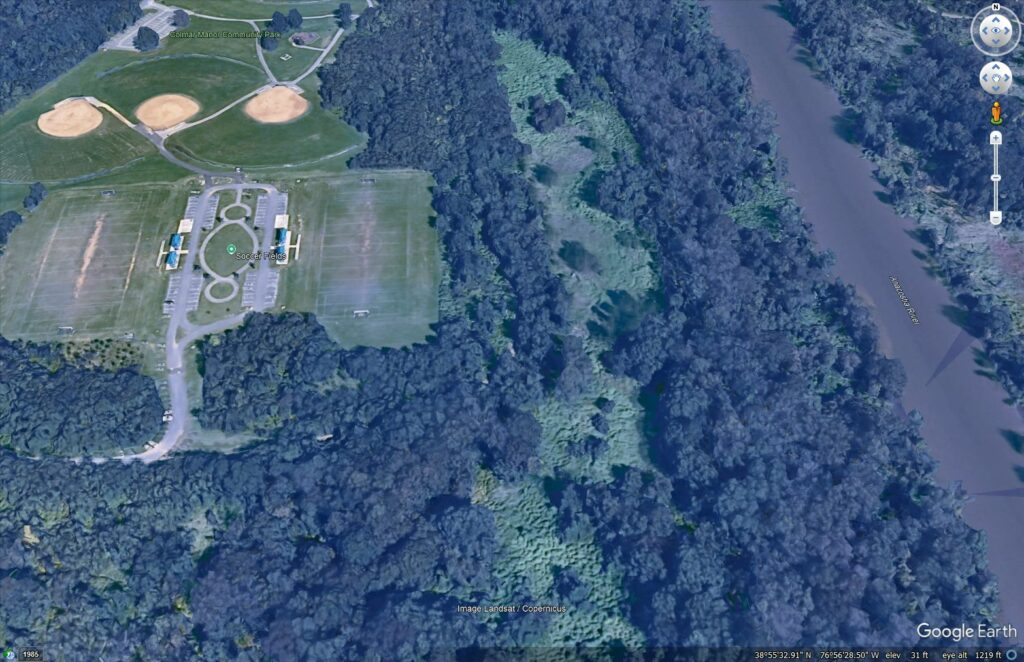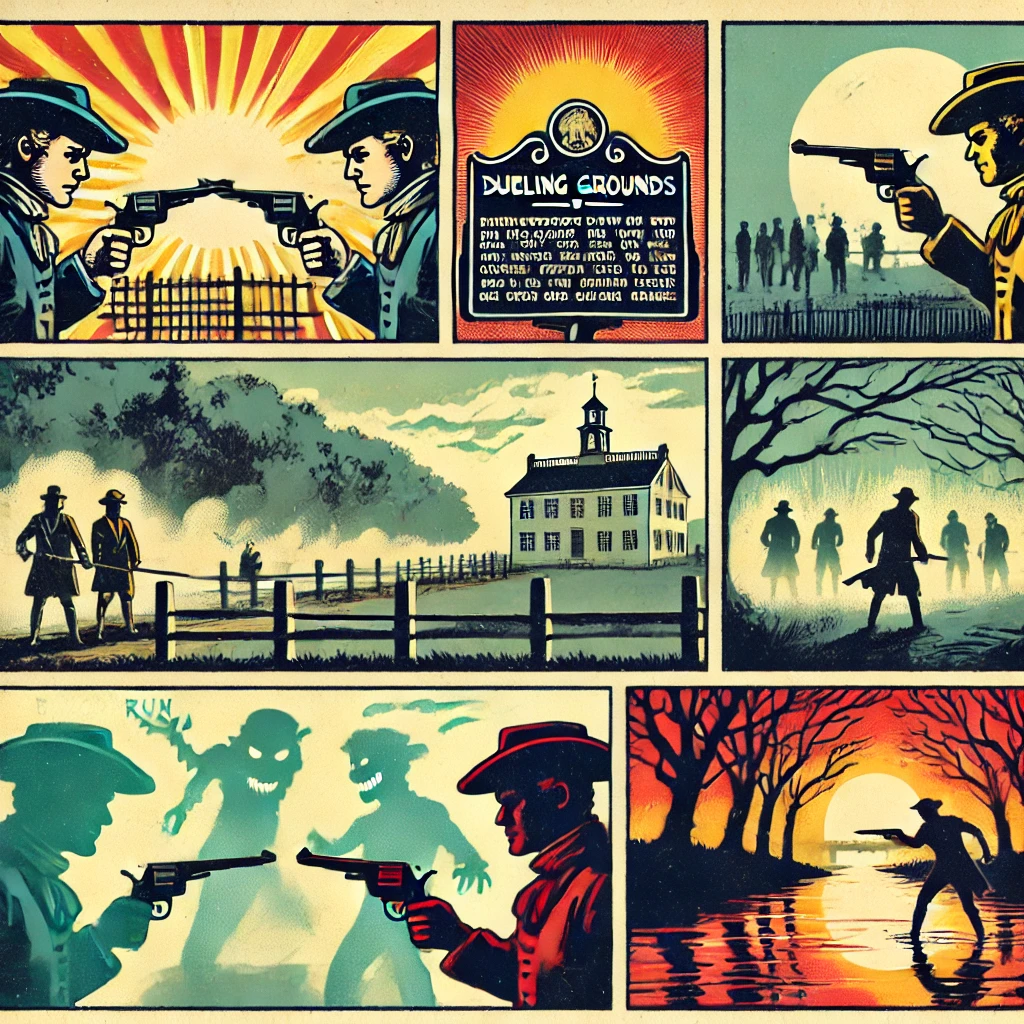Bladensburg Dueling Grounds
The Bladensburg Dueling Grounds, once a notorious site for duels of honor near Washington, D.C., now stands as a historical marker. Events like the deaths of naval hero Stephen Decatur and congressman Jonathan Cilley, along with numerous other duels from 1808-1868, left behind a legacy of honor disputes and ghostly lore. Visitors report seeing shadowy figures walking the grounds, remnants of the past tied to the site’s bloody history. The area, once known as “Blood Run,” retains an eerie atmosphere, blending history with supernatural intrigue.
Naval hero Stephen Decatur is one of many who died from wounds at the infamous Bladensburg Dueling Grounds.
https://en.wikipedia.org/wiki/Bladensburg_Dueling_Grounds
GOOGLE MAP
https://www.google.com/maps?ll=38.925167,-76.940389&q=38.925167,-76.940389&hl=en&t=h&z=15

The Bladensburg Dueling Grounds
Located just beyond and to the northeast of DC. For decades in America’s early days, many men fought there duels of honor.
The dueling grounds are gone, noted now by a historical marker along Route 450 in Maryland. But the events that happened there so many years ago left an indelible impression. Victims of the 50 duels, men like Stephen Decatur, have perhaps left phantoms behind in their wake doomed to endlessly replay events now forgotten.
Death lingered long after dying was over. The duelists who walked away were sometimes scarred forever by what had transpired. In those days, a question of honor was often settled at gunpoint, such as in February of 1819.
Colonel John M. McCarty challenged his cousin, then-former Virginia senator, General Armistead T. Mason. The duel was over a woman’s honor. McCarty believed neither should escape settlement: He proposed they both jump from the (then new) Capitol building or else both sit atop a lighted keg of gunpowder. Unsurprisingly, Mason refused the idiocy. Finally both agreed to fight at 10 paces with single ball muskets.
At next sunrise, the duel took place and Mason was killed. McCarty suffered a wounded hand and lost use of his right arm. In the following years he never forgot that horrible morning but eventually he lost his mind.
It is believed that he has returned to haunt the dueling grounds, never having recovered from murdering his cousin.
Daniel Key, the son of Francis Scott Key (author of the “Star-Spangled Banner”), festered an argument over a long sea voyage with a friend, John Sheburne, over the speed of two steamboats. When they reached Maryland they agreed to a duel on the field of honor. Unlucky Daniel Key was killed with a single shot in June of 1836.

As blood spilled in Bladensburg, ghost stories grew. These stories caused concern over the legality of dueling. Maryland laws did not apply to citizens of DC. In 1838, an incident took place that caused such a public outcry that Congress was forced to act.
Jonathan Cilley, a popular Maine congressman, was shot to death by William Graves, another congressman from Kentucky. Graves had been a stand-in for New York newspaper editor James W. Webb. Cilley had called Webb corrupt, and Graves, being a friend of the editor, took the remark rather personally.
Graves, adept with firearms, challenged Cilley to a duel who thought the whole thing foolish and never expected any duel to actually occur. Nevertheless, he found himself at Bladensburg with a rifle in his hand. The two men took up positions 80 yards apart and both fired. But no one was struck.
Round two. But still, neither fell. They agreed to take one more shot, and this proved fatal for Cilley. His leg was shot out from under him, cutting away an artery and he died in a matter of seconds on the cold ground, leaving a wife and three small children.

Cilley was barely cold before public outcry began. The next session of Congress was forced to make dueling, or accepting or making a challenge, a criminal offense.
The law appeased the public, but it did not end dueling. Instead, challenges were declared in secret and the duelists met in at Bladensburg under the cover of darkness. Not until the Civil War did the “sport” of dueling die out completely.
Bladensburg has since endured change. The small inn, where numerous duelists and their “seconds” met for a toast or some “liquid courage,” is long gone, and urban growth has swallowed all but a small portion of the grounds. A few trees remain with the nearby river that was once called “Blood Run” but now is called “Eastern Branch”.
Some few who visit Bladensburg occasionally report seeing dark, but not transparent, figures walking across the area, apparently specters from another time and place.
Bladensburg is located northeast of Washington, on Highway 202 in Prince Georges County. The former dueling ground is located near Fort Lincoln Cemetery, and a historical marker is located in front of the grounds on Route 450.
Bladensburg Dueling Grounds & Creek Area, Bladensburg/Colmar Manor, MD, off Bladensburg Road, right next to Fort Lincoln Cemetery. Look for the historical marker or you might miss this field area along a small creek just past the D.C. line. This was the preferred site for many duels from 1808-1868 (even though ones were held there since 1732), including the one that killed Stephen Decatur (see Decatur House). There have been reports of shadows and apparitions. This area was also the site of Civil War conflict and earlier battles between the Americans & British in 1814.
http://hometown.aol.com/waniehol/MDplaces.html

The Haunting Legacy of Bladensburg Dueling Grounds
Hidden just outside Washington, D.C., lies a quiet patch of land that once bore witness to deadly rituals of honor and bloodshed. The Bladensburg Dueling Grounds, often referred to as “Blood Run,” is a historic site steeped in lore, tragedy, and ghostly tales that continue to captivate visitors today.
A History Written in Blood
From 1808 to 1868, the Bladensburg Dueling Grounds served as a notorious arena where disputes were settled at the end of a pistol. At a time when a man’s honor could only be redeemed through deadly combat, this unassuming plot became the stage for over fifty duels. Among its most famous incidents was the death of naval hero Stephen Decatur in 1820, a tragedy that sent shockwaves through the nation. Similarly, the fatal duel between congressman Jonathan Cilley and journalist William Graves in 1838 highlighted the deadly consequences of political tensions spilling into personal vendettas.
These duels, often conducted at dawn to avoid law enforcement, were governed by the strict “code of honor,” a set of unwritten rules dictating everything from the choice of weapons to the distance between opponents. While many participants emerged unscathed, others left their lives and legacies on the field, cementing the grounds as a place of both reverence and fear.
Ghosts of the Past
Today, the Bladensburg Dueling Grounds is a historical marker, but its haunted reputation endures. Visitors and paranormal enthusiasts report eerie encounters that seem to echo the site’s violent history. Shadowy figures have been spotted walking the grounds, believed to be the restless spirits of duelists who met their end in the name of honor. Some visitors even claim to feel a cold, oppressive presence lingering near the historical marker, as if the land itself mourns the lives lost.
One of the most chilling features of the area is the nearby river that locals once called “Blood Run.” Legend has it that the river earned its name from the blood spilled during the duels, staining the water in a symbolic testament to the violence of the past. Today, the river is tranquil, but some say its reflection occasionally reveals the spectral forms of duelists preparing for their final moments.
A Site of Reflection and Intrigue
While the dueling grounds may no longer host pistols at dawn, they remain a fascinating site for history buffs, ghost hunters, and curious visitors alike. The land serves as a somber reminder of a bygone era when pride and honor often outweighed the value of life. It also offers an opportunity to reflect on how far we’ve come in resolving disputes—and how much we’ve yet to learn from the echoes of the past.
For those who visit, the Bladensburg Dueling Grounds is more than a historic marker. It’s a space where the past and present coexist, where stories of valor and tragedy whisper through the trees, and where the ghosts of history invite us to listen.